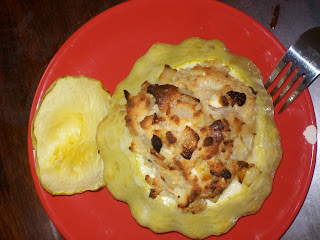I just cooked up this recipe today (my own invention) and it is wonderful. I hope you all enjoy.
Ingredients
3 pattypan squash
3 slices of bread (I used two large loaf heels)
2 medium onions, chopped
1 sausage link (I used smoked kielbasa. Bacon is also a good substitute.)
1/2 cup of bread crumbs
1/4 cup of cheese (I used a mild feta)
1 egg
1 stick of butter
Oil
Preheat the oven to 400º F. Cut top third of the squashes off and scoop out seeds inside to create a small bowl. Steam the squashes until tender (about eight-ten minutes. You can steam them by placing them in a baking dish with a half-inch of water at the bottom. Cover the dish and place in a hot oven.) In a saucepan, caramelize the onions in oil. Put the onions in a medium-bowl. Bisect the sausage along its length, then cut into pieces. Fry up the sausage in the leftover oil from the onions over high heat. Add the sausage, cheese, 1/2 stick of the butter, egg, to the bowl with the onion. Rip and shred the bread and add as well. Mix the stuffing all together, making sure the cheese and butter melt slightly and are evenly distributed. Stuff the stuffing into the squashes. Put the squashes and caps into a baking dish. Use the rest of the butter and top the squashes and their caps with pats of butter (the butter will melt in the oven and soak into the flesh of the squash.) Bake the squashes in the oven until the top of the stuffing starts to uniformly turn brown, about 15 minutes. Serve.
This dish will immediately get you laid if you make it for a girl.




